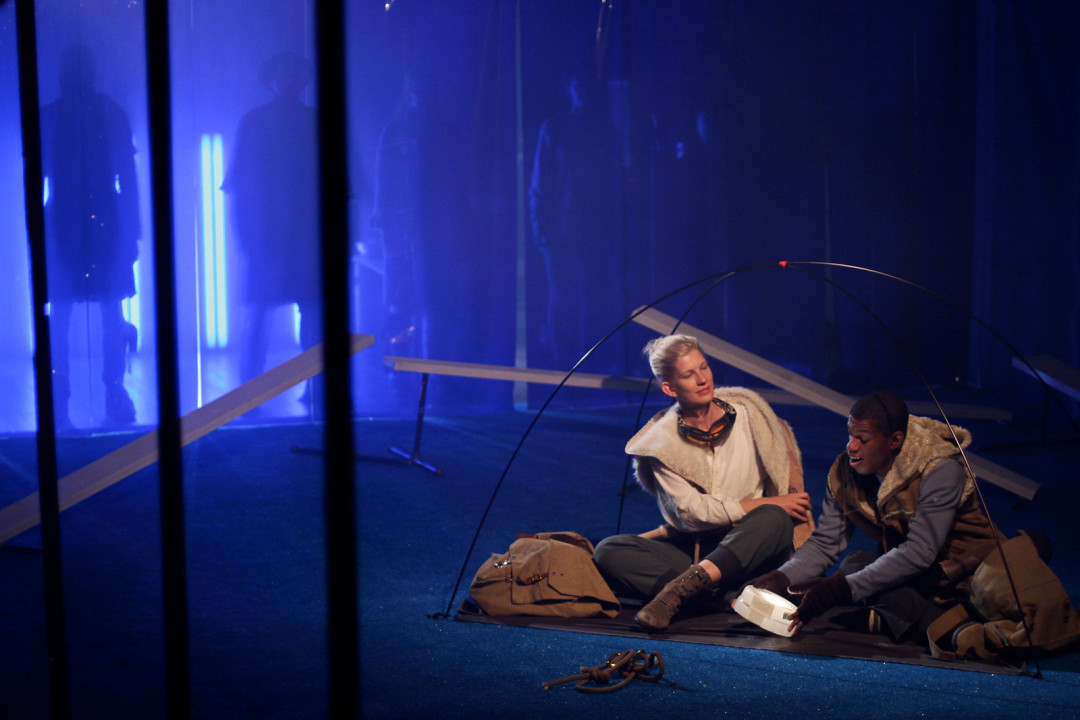Review: Hand2Mouth and Portland Playhouse Tackle ‘Left Hand of Darkness’

Allison Tigard as Estraven and Damian Thompson as Genly in their tent on the Gorbin ice glacier.
Image: Christina Riccetti
In our preview of The Left Hand of Darkness, director Jonathan Walters said that he was originally drawn to the science fiction classic because it was impossible to stage. Ursula K. Le Guin's 1969 story involves an extraterrestrial world of gender-morphous aliens and a dangerous trek across an 800-mile ice glacier. Yet Hand2Mouth Theatre and Portland Playhouse struggle valiantly in their collaborative world premiere to cross that grand barrier of theatrical impossibility. With a bare-bones set and an equally bare-bones budget (although it was the first time both got NEA funding), they manage to create something that almost transports us to that faraway world—a narrative space ship of extension chords and imagination—but ultimately it sputters out, running out of fuel and technology before touching down.
The plot involves a frozen planet inhabited by white, genderless humanoids, who can take on either sex during their fertile period, split into two nations that are skirmishing over borders. Into this combustible icebox steps a black, Earth-born envoy, Genly (played by Damian Thompson with a trepidation—and hoodie and messenger bag—that feels rather contemporary and nonchalant for an intergalactic dignitary), who’s come to invite the planet to join a grand interplanetary coalition, only to be met with fear and distrust. After being thrown into a prison camp by one nation, he is rescued by the exiled prime minister of the other, Estraven (a regal Allison Tigard), who guides him over an 800-mile glacier to safety.
It’s little surprise that Le Guin’s masterpiece (and most sci-fi) has received little theatrical love (it was staged once in Chicago 17 years ago). How does a company, particularly one with a small budget, bring such an otherworldly setting to life? Although Walters said some original ideas involved hundreds of pounds of rock salt or dry ice, ultimately set designer Peter Ksander goes the route of minimalism, building a stage covered in blue AstroTurf and surrounded by a frame of wood and steel bars. The effect is that of looking into a diorama, where our imagination is left to do the heavy lifting, spurred on by the crystalline lighting design of Chris Kuhl and the cinematic, adrenalizing soundscape of Casi Pacilio.
The Left Hand of Darkness
Portland Playhouse
May 2–June 9
The rich themes of the play—which uses literal aliens to explore issues of race, gender, sexuality, nationalism, and, primarily, the delineation of the other—translate to the stage. Patriotism, at one point, is defined by Estraven not as love of one’s country, but “fear of the other.” And ultimately the story is strongest in the second act when it’s just Genly and Estraven together, spanning their differences as they struggle to cross the glacier together.
Yet the storyline itself doesn’t find nearly as smooth a landing. There is so much ground to cover that the script, adapted by University of Oregon professor John Schmor and relying on bulky expository narration, sinks deeper and deeper into the snow with every scene. The two and a half–hour production struggles to maintain momentum as Genly meets one group after another, none of whom grow into characters of much depth beyond Estraven and the crazy king (who is played with delicious if slightly over-the-top insanity by Lorraine Bahr).
Walter’s and H2M’s experimental, collaborative style of theater involves ensemble sequences of stylized movement and song (and, if the first rehearsal was any indication, ensemble directorial decisions) that further weigh things down, particularly in an extended fortune telling ritual and the long transport to the prison camp. While the almost Greek chorus nature of the gender-neutralized ensemble, which is made up of both H2M and Playhouse regulars, helped to evoke our foreign world, I yearned for a more ruthless, autocratic direction to speed us through.
Perhaps I lack in imagination, but I have a hard time envisioning how even a Portland Center Stage–size budget could create the physical suspense and danger that would bring the glacier crossing to frigid life, to say nothing of the full multi-setting scope of the epic journey plot. But if the allure was the impossibility of the voyage, then the ambition and the courage to attempt it should be lauded. And given that H2M usually has a multi-year incubation phase, perhaps in time this voyage, should they continue it, will also touch down.




